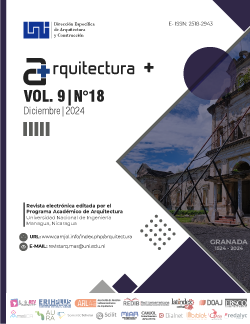Estereotomía digital para la fabricación de bóvedas de arista a escala
DOI:
https://doi.org/10.5377/arquitectura.v9i18.19114Palabras clave:
Bóvedas, Cantería, Digitalización, Estereotomía, Impresión-3D, Manufactura-aditivaResumen
La técnica del corte de la piedra en piezas para la construcción se conoce como estereotomía. Este método de construcción fue desarrollado y perfeccionado durante siglos. Ha sido registrado en algunos tratados de construcción, tales como los de Philibert de l’Orme o Alonso de Vandelvira y funcionó para el desarrollo de la geometría descriptiva. Hoy forma parte de la construcción arquitectónica tradicional de fábricas de cantería y su aplicación en gran medida se limita a la intervención de monumentos. No obstante, la estereotomía es una técnica que continúa siendo desafiante por la dificultad práctica. Desde hace un par de décadas, ha recuperado interés nuevamente en la investigación en arquitectura con la implementación de técnicas digitales como el CAD-CAM, para convertirse en lo que hoy se conoce como estereotomía digital. El objetivo en esta investigación fue identificar como modelar y fabricar por medios digitales una bóveda de arista a escala reducida utilizando procesos de manufactura aditiva de bajo costo. Para cumplir este objetivo, primero se modeló digitalmente una bóveda de arista, pasando su despiece digital desde software CAD, y luego, ejecutando un plan de manufactura digital. Para la manufactura, se utilizó un método aditivo, por medio del Modelado por Deposición Fundida (FDM) con filamento de ácido poliláctico (PLA). Este estudio es de utilidad para comprender un tipo de construcciones con una cantidad representativa de ejemplares y tiene aplicación en la construcción arquitectónica contemporánea.
Descargas
403
Citas
Autodesk, Inc. (2022). Autodesk AutoCAD 2023 Educational version [Computer software]. Obtenido de https://www.autodesk.com/education/edu-software/overview
Calvo López, J. (2002). Superfiies regladas desarrollables y alabeadas en los manuscritos españoles de cantería. IX Congreso Internacional de Expresión Gráfica Arquitectónica. Re-visión: Enfoques en docencia e investigación, (págs. 337-342).
Cavaliere, I., & Graziano, A. V. (2024). 3d Printing Stereotomy: Two Case Studies. En S. Gabriele, A. M. Bertetto, F. Marmo, & A. Micheletti (Edits.), Shell and Spatial Structures (Vol. 437, págs. 416-426). Cham: Springer Nature Switzerland. https://doi.org/https://doi.org/10.1007/978-3-031-44328-2_43
Creality. (2024). Creality Print (5.1.4) (Computer Software). Obtenido de https://www.creality.com/pages/download-software
D'Aviler, A.-C. (1691). Explication Des Termes D'architecture. Paris: Langlois.
de l’Orme, P. (1567). Le premier tome de l’architecture. Paris. Obtenido de https://gallica.bnf.fr/ark:/12148/bpt6k85636g
Fallacara, G. (2006). Digital stereotomy and topological transformations: reasoning about shape building. In Proceedings of the second international congress on construction history, (págs. 1075-1092). Obtenido de https://www.arct.cam.ac.uk/system/files/documents/vol-1-1075-1092-fallacara.pdf
Fallacara, G., & & Barberio, M. (2018a). Stereotomy 2.0: The Rebirth of a Discipline that Never Died. Nexus Network Journal, 20(3), 509-514. https://doi.org/https://doi.org/10.1007/s00004-018-0408-6
Fallacara, G., & Gadaleta, R. (2021). Stereotomy: Architecture and Mathematics. En B. Sriraman (Ed.), Handbook of the Mathematics of the Arts and Sciences (págs. 1325-1344). Cham: Springer International Publishing. https://doi.org/https://doi.org/10.1007/978-3-319-57072-3_85
Fernando, S., Saunders, R., & Weir, S. (2015). Surveying sterotomy: Investigations in arches, vaults and digital stone masonry. Proceedings of the ARCC 2015 Conference (págs. 82-89). Perkins+Will; Architectural Research enters Consortium.
Fletcher, B., & Fletcher, B. F. (1905). Romanesque Vaulting. Craftsman and Amateur. En B. Fletcher, & B. F. Fletcher, A history of architecture on the comparative method. (5th Edition ed., pág. 284). London: B. T. Batsford.
Gadaleta, R. (2018). New stereotomic bond for the dome in stone architecture. . Nexus Network Journal, 20, 707–722.
Galletti, S. (2017). Stereotomy and the Mediterranean: Notes Toward an Architectural History. Mediterranea. International Journal on the Transfer of Knowledge, 2, 73-120. https://doi.org/https://doi.org/10.21071/mijtk.v0i2.6716
Kontovourkis, O., Tryfonos, G., & Georgiou, C. (2020). Robotic additive manufacturing (RAM) with clay using topology optimization principles for toolpath planning: The example of a building element. Architectural Science Review, 63(2), 105-118. https://doi.org/https://doi.org/10.1080/00038628.2019.1620170
Labonnote, N., Rønnquist, A., Manum, B., & Rüther, P. (2016). Additive construction: State-of-the-art, challenges and opportunities. Automation in Construction, 72(347-366). https://doi.org/https://doi.org/10.1016/j.autcon.2016.08.026
Millán-Millán, P. M., Chacón-Carretón, C., & Castela González, C. (2023). The process of digital fabrication and 3D printing as a tool in the study of heritage pathologies: Carcabuey Castle (Cordoba). Virtual Archaeology Review, 14(28), 81-94. https://doi.org/https://doi.org/10.4995/var.2023.18213
Neumüller, M., Reichinger, A., Rist, F., & Kern, C. (2014). 3D Printing for Cultural Heritage: Preservation, Accessibility, Research. En M. Ioannides, & E. Quak, 3D Research Challenges in Cultural Heritage (págs. 119-134). Springer.
Rabasa, E. (2013). Estereotomía: Teoría y práctica, justificación y alarde. Informes de la Construcción, 65((Extra-2)), 5-20. https://doi.org/https://doi.org/10.3989/ic.13.014
Rippmann, M., & Block, P. (2011). Digital Stereotomy: Voussoir geometry for freeform masonry-like vaults informed by structural and fabrication constraints. Conference: Proceedings of the IABSE-IASS Symposium 2011. London.
Sakarovitch, J. (2003). Steroromy, a multifaceted techniques. Proceedings of the First International Congress on Construction History (págs. 69-79). Madrid: I. Juan de Herrera, SEdHC, ETSAM.
Sanabria, S. L. (1989). From Gothic to Renaissance Stereotomy: The Design Methods of Philibert de l’Orme and Alonso de Vandelvira. Technology and Culture, 30(2), 266-299. https://doi.org/https://doi.org/10.1353/tech.1989.0092
Tümer, E. H., & Erbil, H. Y. (2021). Extrusion-Based 3D Printing Applications of PLA Composites: A Review. Coating, 11(390). https://doi.org/https://doi.org/10.3390/coatings11040390
Ultimaker. (2024). Cura (5.6) [Computer software]. Obtenido de https://ultimaker.com/software/ultimaker-cura/
Varela, P. D., & Sousa, J. P. (2017). Fabricating Stereotomy. ACAADe 35. Rome.
Žujović, M., Obradović, ,. R., Rakonjac, I., & Milošević, J. (2022). 3D Printing Technologies in Architectural Design and Construction: A Systematic Literature Review. Buildings, 12(1319). https://doi.org/https://doi.org/10.3390/buildings12091319
Descargas
Publicado
Cómo citar
Número
Sección
Licencia
Derechos de autor 2024 Universidad Nacional de Ingeniería

Esta obra está bajo una licencia internacional Creative Commons Atribución-NoComercial-SinDerivadas 4.0.



















